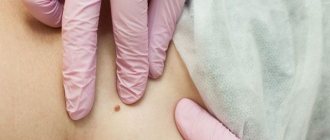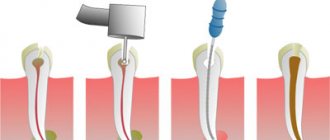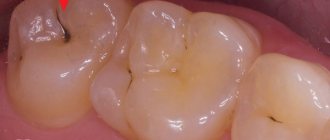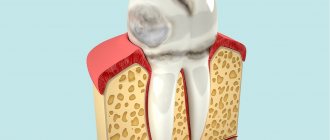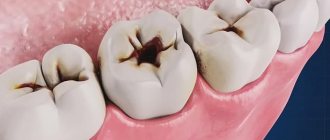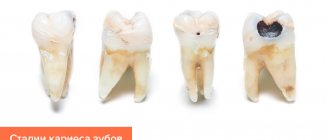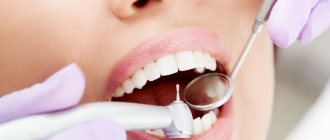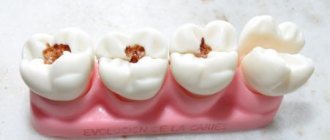Author of the article:
Soldatova Lyudmila Nikolaevna
Candidate of Medical Sciences, Professor of the Department of Clinical Dentistry of the St. Petersburg Medical and Social Institute, Chief Physician of the Alfa-Dent Dental Clinic, St. Petersburg
Modern dentistry has come a long way, and today treating even the most complex cases of caries often does not pose a big problem for doctors. However, despite advances in knowledge and equipment, caries and its treatment are still associated with significant discomfort and the risk of developing dangerous complications. That is why the most effective means of combating this disease remains the prevention of caries.
To do this, you should choose high-quality cleaning products. Asepta offers a line of toothpastes that meet all the requirements for impeccable hygiene. They contain a sufficient amount of minerals that compensate for their deficiency in the enamel; a natural enzyme that effectively breaks down plaque; gentle abrasives that gently whiten teeth.
How to prevent caries and can it be stopped? Unfortunately, the answer may be different in each individual case. The development of caries is closely related not only to personal hygiene, but also to the genetically determined characteristics of the body. However, we can say with confidence that modern methods of caries prevention are quite effective and in many cases make it possible not only to prevent the development or stop the developing carious process, but also to restore the affected tissue.
Primary prevention of dental caries
All methods of preventive control of caries can be divided into primary, secondary and tertiary. Primary ones are aimed at preventing the development of the pathological process. They, in turn, can be divided into endogenous and exogenous.
How to protect teeth from caries, affecting the entire body? Endogenous caries prevention is aimed at achieving this goal. It includes simple but extremely effective methods:
- Balanced healthy diet
- Additional intake of vitamins and other nutrients
- Immune stimulation
Since one of the main causes of caries is the activity of pathogenic microorganisms, the state of local and general immunity plays an extremely important role in its development. For this purpose, immunomodulatory drugs can be used, as well as procedures that have a general strengthening effect on the body. No less effective is creating a healthy diet that excludes foods that have a particularly strong destructive effect on enamel.
These include almost all sweets, carbonated drinks and concentrated juices, fruits (especially sour ones). The general rule is to reduce the amount of carbohydrates and acids, maintaining a balanced diet containing proteins, carbohydrates and fats in optimal proportions.
On the other hand, many products can provide the body with invaluable assistance in the fight against caries. For example, lime is a rich source of calcium and fluoride, green tea prevents the formation of soft plaque, which is a breeding ground for bacteria, and carrots and other hard raw vegetables clean the surface of the teeth well and promote the uniform development of the dental system. It is also necessary to avoid frequent snacking between meals - this will reduce the period during which acids and sugars attack tooth enamel.
Demineralization of teeth is often a consequence of a lack of vitamins, microelements and other nutrients. Their lack causes changes in the structure of enamel and dentin, slows down regeneration processes and prevents the action of compensatory mechanisms. Simply put, the hard outer shells begin to do a worse job of protecting teeth from caries. The most important vitamins for dental health are vitamins A, C and D, as well as fluoride and calcium.
Exogenous methods are those methods that are aimed directly at the teeth and other organs and tissues of the oral cavity. Local and secondary caries prevention (treatment) usually fall into this category.
Exogenous prevention of caries includes the use of the following methods:
- Careful adherence to oral hygiene rules
- Carrying out remineralization
- Professional hygiene
- Fissure sealing
- Bite correction
Let's look at each method in more detail.
DRUG ENDOGENOUS PREVENTION
One of the reasons for the demineralization of dental tissues and the appearance of caries is living in an area where the soil and water are poor in fluoride. Vegetables and fruits grown in such conditions simply cannot contain the required amount of this microelement. As for calcium, the situation here is not the best: not everyone likes dairy products, and for many they are simply contraindicated. Therefore, a regular balanced diet often does not provide the body with all the necessary substances, and dentists recommend that patients take nutritional supplements with calcium, fluoride, vitamins B and D. Water fluoridation gives good results. To increase immunity after illnesses, immunomodulator drugs are used.
However, you should only take fluoride supplements and other medications as directed by your doctor. Excess fluoride in the body leads to a serious disease - fluorosis (the appearance of stains on tooth enamel and its subsequent destruction).
Oral hygiene
Regular hygiene procedures are one of the simplest and at the same time effective methods of preventing dental caries. After each meal, doctors strongly recommend rinsing your mouth, and best of all, brushing your teeth. This must be done within the first five minutes after eating, because it is at this time that they are most intensely affected by aggressive factors.
Hygiene procedures must necessarily include the use of dental floss or toothpicks. The floss allows you to effectively clean the interdental space from food debris, which serves as a breeding ground for pathogenic microflora. In most cases, removing such residues with an ordinary brush is not possible, so the use of thread or floss is absolutely necessary. As an additional remedy, you can use rinses - they have anti-inflammatory and antiseptic effects, help maintain a normal acid-base balance in the mouth and freshen breath.
The choice of hygiene products is also extremely important. An extremely effective remedy is the regular use of toothpastes containing fluoride. Fluoride exposure not only helps strengthen tooth enamel, but also has an inhibitory effect on pathogens and helps remove soft plaque. By integrating into the structure of the enamel, fluoride retains calcium in it and increases the resistance of teeth to various destructive factors.
However, fluoride-containing pastes can only be used in those regions where it is contained in water in an amount of no more than 1.2 mg per 1 liter. Otherwise, fluorosis may develop, a disease that occurs due to an excess of fluoride. If it is impossible to use fluoride prophylaxis, it is necessary to give preference to fluoride-free anti-caries pastes containing antibacterial components and a large amount of calcium.
Primary prevention of tooth decay may also include having your teeth professionally cleaned. In a dental office, a doctor can remove even the most persistent deposits, which are one of the important factors in the mechanism of caries formation. For this purpose, a wide range of means is used - from special medications to high-tech ultrasound equipment.
Prevention of caries with remineralizing agents
The leaching of mineral components from the hard shells of teeth leads to their loosening and weakening - as a result, the tooth’s ability to resist the effects of destructive factors is reduced. In order to solve this problem, special remineralizing agents have been developed for the prevention of caries, which allow the chemical composition of teeth to be restored. The main components of these products are calcium and fluoride.
Today, the following means are used for remineralization:
- Varnishes with a high fluoride content for treating teeth
They are applied using a special brush in a dental office. Varnishes form a protective film on the outer surface of the tooth. The procedure must be carried out two to four times a year to achieve a sustainable effect. You should refrain from eating for two hours after applying the varnish. - Professional medicinal pastes
Suitable for home use. Application - daily or several times a week. It is not recommended to use medicated pastes (especially fluoride-containing ones) in children under 3 years of age. - Gels and other astringent external products for applications
can be used as independent products, as well as as auxiliaries during electrophoresis. They are applied and fixed to the surface using special spoons or trays. The procedure is repeated several times a year. - Fluoride-containing solutions and mouth rinses
can also be used independently. - Fluoride Discs
Using a handpiece, a rotating disc containing a high mineral content is literally rubbed into the surface of the tooth, allowing extremely deep penetration of the active ingredients.
The importance of treating a carious tooth
Caries usually develops slowly. At the initial stage, it looks like a white spot, which can be gotten rid of in the most gentle way possible without preparing the carious cavity - using special gels and solutions. As the pathology progresses, the infection penetrates deeper and can cause inflammation of the neurovascular bundle. At this stage, you cannot do without drilling, cleaning and filling the cavity. If caries is not treated, the tooth may completely decay and will have to be removed.
In addition, the affected unit is a source of infection and can cause chronic diseases and destruction of adjacent teeth. When the chewing function of the unit is impaired, the patient gradually develops gastrointestinal diseases. And, of course, a tooth damaged by caries looks unaesthetic.
Remember: the longer you delay visiting a doctor, the more the tooth will decay, and the more expensive its treatment will be. So, at the slightest suspicion of a problem, it is better to consult a dentist.
Fissure sealing
One of the latest words in the prevention of caries in adults and children is a procedure called “fissure sealing.” Fissures are natural depressions located on the chewing surface of the teeth (especially noticeable on molars). At the bottom of such depressions there is soft enamel with a low degree of mineralization; In addition, food debris and bacterial mass often accumulate in the fissures. As a result, it is the weak enamel of these depressions that often becomes the entry point for infection, leading to damage or loss of the tooth.
Fissures can be either closed or open (you can touch the bottom of the recess with the instrument). In order to protect them from caries, a sealing procedure is carried out. To do this, the recesses are treated with a special solution and then filled with dental sealant consisting of materials resistant to acids and alkalis. “Sealing” fissures is an extremely effective measure for the prevention of childhood caries and caries in adolescents. However, the procedure can be performed on patients up to 55 years of age. The sealing effect lasts for 4-5 years. After this period is completed, the procedure can be repeated without damaging the health of the teeth. Contraindications to the procedure are the presence of fissure caries and poor oral hygiene.
Treatment of caries in our dentistry
If your child has dental problems or you want to prevent caries, we invite you to our clinic. We have excellent doctors who are well versed in child psychology and the treatment of dental diseases in children. We will provide a high-quality consultation, help the child get rid of fear of the dentist, if he has one, teach him how to brush his teeth correctly, and carry out all the necessary procedures to prevent the development of caries. Our child will receive only positive emotions!
How to stop tooth decay: correcting your bite
According to many, malocclusion is a minor cosmetic defect that does not have a major impact on dental health. In some cases this may be true; However, malocclusion can also cause uneven distribution of stress on the teeth during chewing, which, in turn, leads to premature wear. Without time to recover from mechanical stress, the enamel becomes much more susceptible to the effects of other destructive factors, which ultimately can lead to the onset of the carious process.
That is why bite correction should also be included in the list of preventive procedures. To correct it today, a wide range of technologies and methods are used - from installing braces to surgical intervention.
What to do if caries has already appeared
You need to understand that treating a disease such as caries at home is almost impossible. The specialists of the Dent Prestige clinic will definitely help you solve this problem. If a person notices that his teeth are turning black, small holes appear and there is pain, then he should do the following:
- contact a highly qualified dentist;
- undergo examination and dental treatment;
- restore damaged areas of teeth in the dental office by installing fillings, extensions or implants.
If a person does not pay attention to one diseased tooth, then the next ones will begin to deteriorate. That is why, if there is the slightest blackening, you should immediately go to the dental clinic and resolve the situation before it gets too advanced.
Only a professional dentist knows how to remove caries from teeth, and it is worth contacting him. To prevent caries, you should take care of your dental health from childhood. There is no need to think that baby teeth should not be treated, because it is their condition that determines how healthy the permanent teeth will grow.
Clinical researches
ASEPTA toothpastes are clinically proven effective. For example, clinical studies have proven that regular use of professional toothpaste ASEPTA REMINERALIZATION improved the condition of the enamel by 64% and reduced tooth sensitivity by 66% after just 4 weeks.
In addition, clinical studies have proven that regular use of preventive toothpaste ASEPTA ACTIVE for a month can reduce bleeding gums by 60%, improve the overall condition of the oral cavity by 44% and reduce inflammation by 33%.
Sources:
- Report on determining/confirming the preventive properties of toothpaste “ASEPTA PLUS” GENTLE WHITENING” Author: doctor-researcher A.A. Leontyev, head Department of Preventive Dentistry, Doctor of Medical Sciences, Professor S.B. Ulitovsky First St. Petersburg State Medical University named after. acad. I.P. Pavlova, Department of Preventive Dentistry
- Clinical and laboratory assessment of the influence of domestic therapeutic and prophylactic toothpaste based on plant extracts on the condition of the oral cavity in patients with simple marginal gingivitis. Doctor of Medical Sciences, Professor Elovikova T.M.1, Candidate of Chemical Sciences, Associate Professor Ermishina E.Yu. 2, Doctor of Technical Sciences Associate Professor Belokonova N.A. 2 Department of Therapeutic Dentistry USMU1, Department of General Chemistry USMU2
- Report on the determination/confirmation of the preventive properties of personal oral hygiene products “ASEPTA PLUS” Remineralization doctor-researcher A.A. Leontyev, head Department of Preventive Dentistry, Doctor of Medical Sciences, Professor S.B. Ulitovsky First St. Petersburg State Medical University named after. acad. I.P. Pavlova, Department of Preventive Dentistry
- Clinical studies of antisensitive toothpaste “Asepta Sensitive” (A.A. Leontyev, O.V. Kalinina, S.B. Ulitovsky) A.A. LEONTIEV, dentist O.V. KALININA, dentist S.B. ULITOVSKY, Doctor of Medical Sciences, Prof. Department of Therapeutic Dentistry, St. Petersburg State Medical University named after. acad. I.P. Pavlova
- The role of anti-inflammatory rinse in the treatment of periodontal diseases (L.Yu. Orekhova, A.A. Leontyev, S.B. Ulitovsky) L.Yu. OREKHOVA, Doctor of Medical Sciences, Prof., Head of Department; A.A. LEONTIEV, dentist; S.B. ULITOVSKY, Doctor of Medical Sciences, Prof. Department of Therapeutic Dentistry of St. Petersburg State Medical University named after. acad. I. P. Pavlova
- Report on determining/confirming the preventive properties of toothpaste “ASEPTA PLUS” COFFEE and TOBACCO Author: doctor-researcher A.A. Leontyev, head Department of Preventive Dentistry, Doctor of Medical Sciences, Professor S.B. Ulitovsky. First St. Petersburg State Medical University named after. acad. I.P. Pavlova, Department of Preventive Dentistry
- Report on determining/confirming the preventive properties of commercially produced personal oral hygiene products: Asepta toothpaste used in combination with Asepta mouthwash and Asepta gum balm Head. Department of PFS Doctor of Medical Sciences Professor S.B. Ulitovsky St. Petersburg State Medical University named after Academician I.P. Pavlova. Faculty of Dentistry. Department of Preventive Dentistry.
Risk factors for dental caries
Back in 1890, it was proven that the main role in the development of caries is played by the fermentation of carbohydrates under the influence of bacteria living in the oral cavity [2]. Based on this, the most significant risks for caries prevention are:
- Dental plaque and the colonies of microorganisms inhabiting it.
- Excess sugar in food.
- Lack of fluoride in drinking water and food[1]. This chemical element is so important because its compounds (fluorides) increase the resistance of enamel to acids, strengthen its crystal lattice, and suppress the growth of harmful microflora [1, 2].
“For every sugar molecule, two molecules of lactic acid are formed, and many people already know how lactic acid affects teeth.
It actually dissolves teeth and leads, through a series of processes, to the appearance of caries. Therefore, the problem of caries cannot be considered without the question of sugar consumption” [3]. Leontyev V.K., Academician of the Russian Academy of Sciences, Honored Scientist of the Russian Federation, Vice-President of the Dental Association of Russia, Doctor of Medical Sciences, Professor, Head of the Science Department of the Moscow State Medical and Dental University named after A. I. Evdokimov
It is sugar that is often blamed for the fact that the population of developed countries is susceptible to tooth decay. In them (including in Russia) they eat a large number of foods with a high content of it: candy, baked goods, ice cream, sweet soda. At the same time, historically there was almost no sugar in the human diet, and people did not develop effective mechanisms to protect themselves from its harmful effects.


